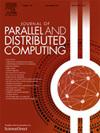Line formation and scattering in silent programmable matter
IF 3.4
3区 计算机科学
Q1 COMPUTER SCIENCE, THEORY & METHODS
引用次数: 0
Abstract
Programmable Matter (PM) has been widely investigated in recent years. It refers to some kind of substance with the ability to change its physical properties (e.g., shape or color) in a programmable way. In this paper, we refer to the model, where the particles live and move on a triangular grid, are asynchronous in their computations and movements, and do not possess any direct means of communication (silent) or memory of past events (oblivious).
Within , we aim at studying Spanning problems, i.e., problems where the particles are required to suitably span all over the grid. We first address the Line Formation problem where the particles are required to end up in a configuration where they all lie on a line, i.e., they are aligned and connected. Secondly, we deal with the more general Scattering problem: starting from any initial configuration, we aim at reaching a final one where no particles occupy neighboring nodes. Furthermore, we investigate configurations where some nodes of the grid can be occupied by unmovable elements (i.e., obstacles) from both theoretical and experimental view points.
无声可编程物质中的线形成和散射
可编程物质(PM)近年来得到了广泛的研究。它指的是某种能够以可编程的方式改变其物理特性(例如形状或颜色)的物质。在本文中,我们引用了SILBOT模型,其中粒子在三角形网格上生活和移动,它们的计算和运动是异步的,并且不具有任何直接的通信手段(沉默)或过去事件的记忆(遗忘)。在SILBOT中,我们的目标是研究跨越问题,即要求粒子适当地跨越整个网格的问题。我们首先解决线的形成问题,其中粒子被要求最终在一个配置,他们都躺在一条线上,即,他们是对齐和连接。其次,我们处理更一般的散射问题:从任何初始配置开始,我们的目标是达到没有粒子占据邻近节点的最终配置。此外,我们从理论和实验的角度研究了网格的一些节点可以被不可移动的元素(即障碍物)占用的配置。
本文章由计算机程序翻译,如有差异,请以英文原文为准。
求助全文
约1分钟内获得全文
求助全文
来源期刊

Journal of Parallel and Distributed Computing
工程技术-计算机:理论方法
CiteScore
10.30
自引率
2.60%
发文量
172
审稿时长
12 months
期刊介绍:
This international journal is directed to researchers, engineers, educators, managers, programmers, and users of computers who have particular interests in parallel processing and/or distributed computing.
The Journal of Parallel and Distributed Computing publishes original research papers and timely review articles on the theory, design, evaluation, and use of parallel and/or distributed computing systems. The journal also features special issues on these topics; again covering the full range from the design to the use of our targeted systems.
 求助内容:
求助内容: 应助结果提醒方式:
应助结果提醒方式:


